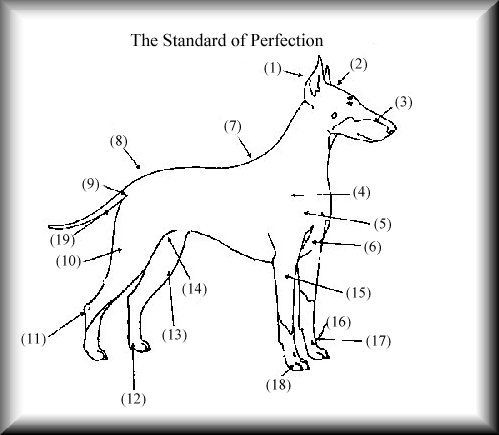

(1) Correct ears for the Standard variety are either the naturally erect ear, the cropped ear, or the button ear. No preference is given to any of the ear types. The naturally erect ear, and the button ear, should be wider at the base tapering to pointed tips, and carried well up on the skull. Wide, flaring, blunt tipped or "bell" ears are a serious fault. Cropped ears should be long, pointed and carried erect. The only correct ear in the Toy variety is the naturally erect ear. They should be wider at the base tapering to pointed tips, and carried well up on the skull. Wide, flaring, blunt tipped or "bell" ears are a serious fault. Cropped or cut ears are a disqualification in the Toy variety. The Standard of Perfection describes an ideal toward which we should all strive in order to attain maximum breed improvement.
(2) The head is long, narrow, tight skinned and almost flat with a slight indentation up the forehead. It resembles a blunted wedge in frontal and profile views. There is a visual effect of a slight stop as viewed in profile.
(3) The muzzle and skull equal in length. The muzzle well filled under the eyes with no visible cheek muscles. The underjaw full, well defined - nose is black. Teeth white and strongly developed with a true scissors bite. Level bite is acceptable.
(4) The shoulder blades and the upper arm should be relatively the same length. The distance from the elbow to the withers should be approximately the same as the distance from the elbow to the ground. The elbows should lie in close to the brisket. The shoulders are well laid back.
(5) The Manchester Terrier, overall, is slightly longer than tall. The height measured vertically from the ground to the highest point of the withers, is slightly less than the length, measured horizontally from the point of the shoulders to the rear projection of the upper thigh. The bone and muscle of the Manchester Terrier is of sufficient mass to ensure agility and endurance.
(6) The chest is narrow between the legs and deep in the brisket. The forechest is moderately defined. The ribs are well sprung, but flattened in the lower end to permit clearance of the forelegs.
(7) The slightly arched neck should be slim and graceful, and of moderate length. It gradually becomes larger as it approaches, and blends smoothly with the sloping shoulders. Throatiness is undesirable.
(8) The topline shows a slight arch over the robust loins falling slight to the tail set. A flat back or roached back is to be severely penalized.
(9) The taper style tail is moderately short reaching no further than the hock joint. It is set at the end of the croup. Being thicker where it joins the body, the tail tapers to a point. The tail is carried in a slight upward curve, but never over the back.
(10) The thigh should be muscular with the length of the upper and lower thighs being approximately equal.
(11) The well let down hocks should not turn in nor out as viewed from the rear. The hind legs are carried well back.
(12) The hind feet are shaped like those of a cat with thick pads and jet black nails.
(13)The stifle is well turned.
(14)The abdomen should be tucked up extending in an arched line from the deep brisket.
(15) The forelegs are straight, of proportional length and place well under the brisket.
(16) The pasterns should be almost perpendicular.
(17) There should be a black "thumbprint" patch on the front of each foreleg at the pastern. The remainder of the foreleg shall be tan to the carpus joint.
(18) There should be a distinct black "pencil mark" line running lengthwise on the top of each toe on all four feet.
(19) There should be tan under the tail, and on the vent, but only of such size as to be covered by the tail.
It is hardly to be expected that we will ever see a perfect specimen - one which conforms exactly to all Standard specifications. Progress in breed improvement - and the degree of success attained by an individual breeder - will depend not so much on the occasional production of a single outstanding specimen, as upon our ability to recognize, and then intelligently use such specimens so as to make our breed in general more nearly approach the 'ideal'.
There are two basic fundamentals which apply with equal force to both breeders and judges and which are essential to desired progress. They are:
(1) A thorough knowlege of the desirable qualities and their relative values as established by the Standard.
(2) An ability to recognize and to evaluate the seriousness of, the more common faults.
In conjunction with such a Standard, an attempt will be made to set forth some of the more serious faults which the breeders should strive to eliminate, and which the judges should especially penalize should they appear in the show ring.
We hope to inform you on the following pages, what the Standard determines 'Ideal Type' and 'Incorrect Type'.

